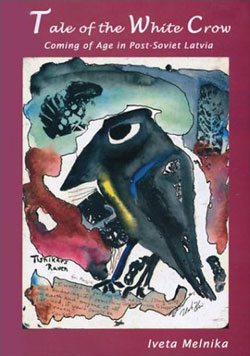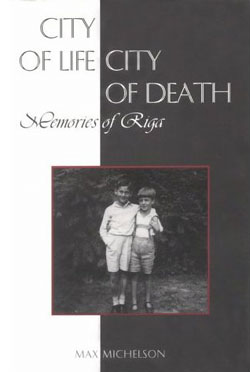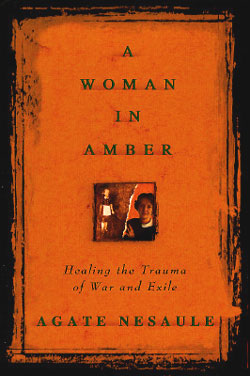
The white crow of Iveta Melnika’s memoir is an outcast: an ugly duckling among the swans, a white crow among the black. This is how the teenaged Melnika perceives herself: ugly, shy, and despised by her peers. Tale of the White Crow tells the story of her coming-of-age in the turbulent period of Latvia’s independence from the Soviet Union.
Although Tale of the White Crow is subtitled “Coming of Age in Post-Soviet Latvia,” Melnika’s painful journey through adolescence begins before Independence, while Latvia is firmly under Soviet rule. Melnika is conscious of the inequities of life under the Soviets: though everyone is supposedly equal, families who are well-connected or who have relatives in the West enjoy a superior lifestyle. Meanwhile, Melnika’s family struggles along in one room of a communal apartment. Her father cannot work because of a severe heart condition and Melnika’s white crow status at school is exacerbated by her family’s poverty.
Change begins slowly, with a few people wearing badges of the Latvian flag. Political events are filtered through Melnika’s teenaged consciousness: “I had to stand for hours in the hot sun, listening to boring talks, and watched some weird people putting the flowers at the foot of the Freedom Monument.” Gradually, she becomes more interested. Deeply moved by the human chain holding hands across the Baltics (on Brīvības Street there were “so many that they had to stand three, four deep”), Melnika joins a pilgrimage of thousands to commemorate Latvians lost in the mass deportations of the 1940s. Should the Russians invade again, she doesn’t expect the West to intervene. “And why should they care? …Pampered by their good fortune, they are unable to comprehend our desperate, even ridiculous fight for survival as a nation with its own language and cultural values.”
Melnika’s adolescence is rocky but not untypical. She thinks she is ugly and repulsive, that others hate and mock her. Sometimes she wonders if she isn’t crazy. “Maybe if I had jeans my classmates would look differently at me.” Her own jeans are undesirable Polish knock-offs. Or if only she had a boyfriend! Melnika craves the change of status that such a commodity would bestow on an ugly duckling like herself. She doesn’t even aspire to turn into a swan, she says, but would settle for becoming a decent duck.
Her grandmother has taught her to believe in God, to whom, she says, looks don’t matter. “Yeah, not to Him,” Melnika comments, “but they definitely matter to people, and very very much, by the way.” Her hunger for love and belonging leads Melnika to join the Church of Christ, which is aggressively evangelizing in post-Soviet Russia and eastern Europe. Her parents disapprove, afraid that the church is a cult that preys on young people. Melnika tries hard not to believe this, though she has her own misgivings. The church leadership demands unquestioning obedience: “Do you know why Satan is in hell? It’s because he is proud and rebellious. Just like you are now.”
After years of repression, Latvia is vulnerable to the tactics of American cults, and to corruption. Unbridled capitalism exacts a savage toll from Latvian society. The result is immense suffering, and nostalgia for the meagre certainties of Soviet times. Former inequalities seem slight in view of the widening gulf between rich and poor. While the elderly starve or commit suicide, Rīga’s streets are clogged with luxury cars. Gangsters buy huge flats downtown and spend their evenings in expensive discos and restaurants.
Iveta too has her disco period, a time of emptiness and searching that leaves her even lonelier than before. Afterwards she is as depressed as she has ever been, still without the love she longs for and outside the church where she found, at least briefly, a sense of community. However, she manages to obtain an education and stay afloat. As she points out after one typically disastrous social encounter, she must learn from these experiences for they will help to prepare her for the future: “If I manage to get through this, I am one step closer to the big life now.”
Tale of the White Crow came into being because of a chance meeting of the author and David Pichaske, the publisher, while the latter was teaching in Rīga on a Fulbright fellowship. (The book actually was printed in Mongolia, another of Pichaske’s foreign assignments.) Part of the book’s considerable charm derives from its idiosyncratic idiom, which the author wished to “normalize” as her English language skills became more sophisticated. Happily, Pichaske argued for the original and to some extent prevailed. His photographs of Latvia are included.
Details
Tale of the White Crow: Coming of Age in Post-Soviet Latvia
Iveta Melnika
Granite Falls, Minnesota: Ellis Press, 2003
ISBN 0-944024-46-7
Where to buy
Purchase Tale of the White Crow: Coming of Age in Post-Soviet Latvia from Amazon.com.
Note: Latvians Online receives a commission on purchases.





